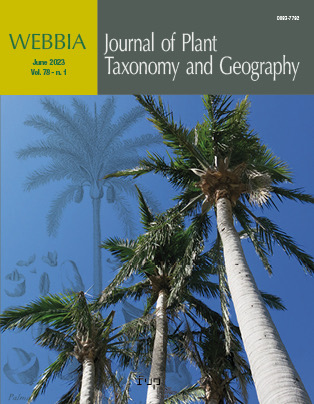Published 2023-05-14
Keywords
- Calyptrata clade,
- endemic species,
- Samar Island Natural Park,
- Araceae,
- Schismatoglottis
How to Cite
Copyright (c) 2023 Marjorie D. delos Angeles, Danilo N. Tandang, Maria Melanie P. Medecilo-Guiang, Inocencio E. Buot, Jr., Harald Schneider, Marcos A. Caraballo-Ortiz

This work is licensed under a Creative Commons Attribution 4.0 International License.
Abstract
Schismatoglottis minuta (Araceae) is described as a new species and illustrated based on accessions collected from Samar Island, Philippines. The new species, belonging to the Calyptrata clade sensu Hay and Yuzammi is distinct from previously reported taxa. Due to its habitat preferences and low (<100) estimated number of mature individuals, we recommend that this noteworthy species should be considered as critically endangered.
References
Angeles MDD, Rubite RR, Chung KF, Buot Jr IE, Tandang DN. 2022. Begonia normaaguilariae (section Baryandra, Begoniaceae), a new species from the limestone forests of Samar Island, Philippines. Phytotaxa 541(1):49–56. https://doi.org/10.11646/phytotaxa.541.1.4.
Boyce PC, Wong SY. 2015. Studies on Schismatoglottideae (Araceae) of Borneo L—Schismatoglottis meriaraeinsis, a new limestone-obligated species with viviparous leaves. Telopea 18:443–450.
Boyce PC, Medecilo MP, Wong SY. 2015. A new and remarkable aquatic species of Schismatoglottis (Araceae) from the Philippines. Willdenowia 45(3):405–408. https://doi.org/10.3372/wi.45.45304.
De Queiroz K. 2007. Species concepts and species delimitation. Systematic Biology 56(6):879–886. https://doi.org/10.1080/10635150701701083.
Engler A. 1912. Homalomeninae und Schismatoglottidinae. In: Engler A, Krause K, editors. Araceae-Philodendrioideae-Philodendreae. Wilhelm Engelmann, Leipzig: Das Pflanzenreich 55 Vol. IV.23DA; p. 1–134.
Hay A. 1996 The genus Schismatoglottis Zoll. & Moritzi (Araceae: Schismatoglottideae) in Peninsular Malaysia and Singapore. Sandakania 7:1–30.
Hay A, Yuzammi. 2000. Schismatoglottidea (Araceae) in Malesia I – Schismatoglottis. Telopea 9(1):1–177.
IUCN Standards and Petitions Committee. 2019. Guidelines for Using the IUCN Red List Categories and Criteria. Version 15. https://www.iucnredlist.org/resources/redlistguidelines [accessed 7 February 2023].
Moritzi A, Léveillé JH, Schaerer L, Duby JE. 1846. Systematisches Verzeichniss der von H. Zollinger. Java 83: 590.
Pelser PB, Barcelona JF, Nickrent DL (editors). 2011–onwards. Co’s digital flora of the Philippines. http://www.philippineplants.org [accessed 7 February 2023].
Tandang DN, delos Angeles M, Inocencio Jr EB, Devkota MP, Caraballo-Ortiz MA. 2022. Decaisnina tomentosa(Loranthaceae), a new species of mistletoe from Samar Island, Philippines. Biodiversity Data Journal 10:e78457. https://doi.org/10.3897/BDJ.10.e78457.
Thiers BM. 2022 (updated continuously). Index Herbariorum: A global directory of public herbaria and associated staff. New York Botanical Garden’s Virtual Herbarium, New York. http://sweetgum.nybg.org/science/ih [accessed 7 February 2023].
Tolentino PJS, Navidad JRL, Angeles MDD, Fernandez DAP, Villanueva ELC, Obeña RDR, Buot Jr IE. 2020. Biodiversity of forests over limestone in Southeast Asia with emphasis on the Philippines. Biodiversitas, Journal of Biological Diversity 21(4):1597–1613. https://doi.org/10.13057/biodiv/d210441.
van Alderwerelt van Rosenburgh CRWK. 1922. New or noteworthy Malayan Araceae 2. Bulletin du Jardin Botanique de Buitenzorg 3(4):163–229.
Wong SY, Bogner J, Boyce PC. 2010. A new endemic species of Schismatoglottis (Araceae) from the Philippines. Willdenowia 41(1):101–106.
Wong SY. 2012. Studies on Schismatoglottideae (Araceae) of Borneo XXI: two new species of Schismatoglotis calyptratagroup: Schismatoglottis heterodox and Schismatoglossis ranchanensis. Willdenowia 42:255–260.
Wong SY, Hoe YC, Boyce PC. 2016. Studies on Schismatoglottideae (Araceae) of Borneo LIX - a preliminary conspectus of Schismatoglottis calyptrata Clade species for Sarawak. Aroideana 39:71–100.
Wong SY, Hay A, Boyce PC. 2018. An annotated checklist of Schismatoglottis. Aroideana 41:34–200.
Wong SY, Boyce PC. 2020. Studies on Schismatoglottideae (Araceae) of Peninsular Malaysia II: Schismatoglottis guabatuensis [Calyptrata clade], a new locally endemic limestone-obligated species. Nordic Journal of Botany 38(9):e02808. https://doi.org/10.1111/njb.02808.
Wong SY, Boyce PC. 2021. Studies on Schismatoglottideae (Araceae) of Borneo LXX — new colonial species for the Schismatoglottis (Calyprata clade) from Sarawak. Journal of Plant Taxonomy and Geography (Webbia) 76:221–243. https://doi.org/1036253/jopt-10798.


